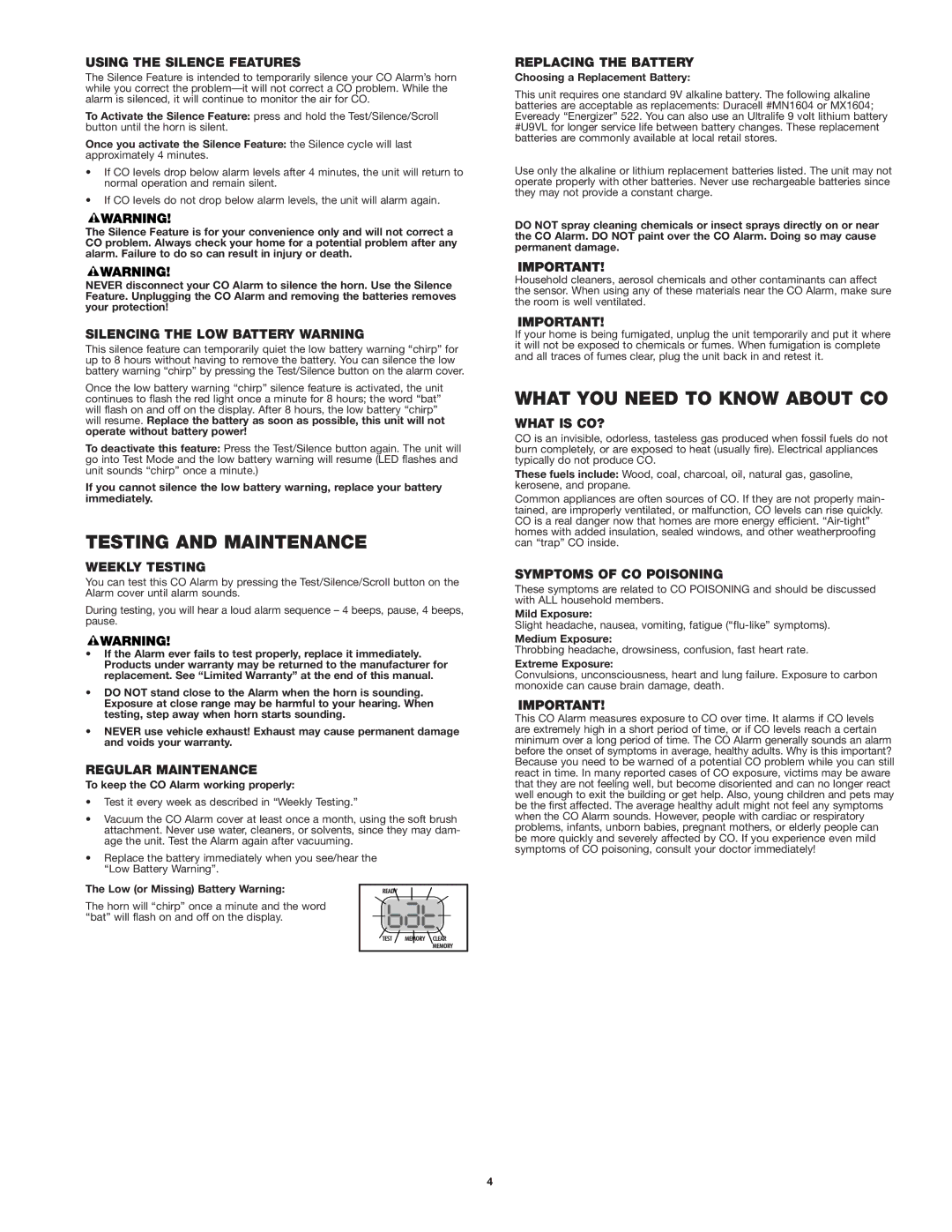
USING THE SILENCE FEATURES
The Silence Feature is intended to temporarily silence your CO Alarm’s horn while you correct the
To Activate the Silence Feature: press and hold the Test/Silence/Scroll button until the horn is silent.
Once you activate the Silence Feature: the Silence cycle will last approximately 4 minutes.
•If CO levels drop below alarm levels after 4 minutes, the unit will return to normal operation and remain silent.
•If CO levels do not drop below alarm levels, the unit will alarm again.
The Silence Feature is for your convenience only and will not correct a CO problem. Always check your home for a potential problem after any alarm. Failure to do so can result in injury or death.
NEVER disconnect your CO Alarm to silence the horn. Use the Silence Feature. Unplugging the CO Alarm and removing the batteries removes your protection!
SILENCING THE LOW BATTERY WARNING
This silence feature can temporarily quiet the low battery warning “chirp” for up to 8 hours without having to remove the battery. You can silence the low battery warning “chirp” by pressing the Test/Silence button on the alarm cover.
Once the low battery warning “chirp” silence feature is activated, the unit continues to flash the red light once a minute for 8 hours; the word “bat” will flash on and off on the display. After 8 hours, the low battery “chirp” will resume. Replace the battery as soon as possible, this unit will not operate without battery power!
To deactivate this feature: Press the Test/Silence button again. The unit will go into Test Mode and the low battery warning will resume (LED flashes and unit sounds “chirp” once a minute.)
If you cannot silence the low battery warning, replace your battery immediately.
TESTING AND MAINTENANCE
WEEKLY TESTING
You can test this CO Alarm by pressing the Test/Silence/Scroll button on the Alarm cover until alarm sounds.
During testing, you will hear a loud alarm sequence – 4 beeps, pause, 4 beeps, pause.
•If the Alarm ever fails to test properly, replace it immediately. Products under warranty may be returned to the manufacturer for replacement. See “Limited Warranty” at the end of this manual.
•DO NOT stand close to the Alarm when the horn is sounding. Exposure at close range may be harmful to your hearing. When testing, step away when horn starts sounding.
•NEVER use vehicle exhaust! Exhaust may cause permanent damage and voids your warranty.
REGULAR MAINTENANCE
To keep the CO Alarm working properly:
•Test it every week as described in “Weekly Testing.”
•Vacuum the CO Alarm cover at least once a month, using the soft brush attachment. Never use water, cleaners, or solvents, since they may dam- age the unit. Test the Alarm again after vacuuming.
•Replace the battery immediately when you see/hear the “Low Battery Warning”.
The Low (or Missing) Battery Warning:
The horn will “chirp” once a minute and the word “bat” will flash on and off on the display.
REPLACING THE BATTERY
Choosing a Replacement Battery:
This unit requires one standard 9V alkaline battery. The following alkaline batteries are acceptable as replacements: Duracell #MN1604 or MX1604; Eveready “Energizer” 522. You can also use an Ultralife 9 volt lithium battery #U9VL for longer service life between battery changes. These replacement batteries are commonly available at local retail stores.
Use only the alkaline or lithium replacement batteries listed. The unit may not operate properly with other batteries. Never use rechargeable batteries since they may not provide a constant charge.
DO NOT spray cleaning chemicals or insect sprays directly on or near the CO Alarm. DO NOT paint over the CO Alarm. Doing so may cause permanent damage.
Household cleaners, aerosol chemicals and other contaminants can affect the sensor. When using any of these materials near the CO Alarm, make sure the room is well ventilated.
If your home is being fumigated, unplug the unit temporarily and put it where it will not be exposed to chemicals or fumes. When fumigation is complete and all traces of fumes clear, plug the unit back in and retest it.
WHAT YOU NEED TO KNOW ABOUT CO
WHAT IS CO?
CO is an invisible, odorless, tasteless gas produced when fossil fuels do not burn completely, or are exposed to heat (usually fire). Electrical appliances typically do not produce CO.
These fuels include: Wood, coal, charcoal, oil, natural gas, gasoline, kerosene, and propane.
Common appliances are often sources of CO. If they are not properly main- tained, are improperly ventilated, or malfunction, CO levels can rise quickly. CO is a real danger now that homes are more energy efficient.
SYMPTOMS OF CO POISONING
These symptoms are related to CO POISONING and should be discussed with ALL household members.
Mild Exposure:
Slight headache, nausea, vomiting, fatigue
Medium Exposure:
Throbbing headache, drowsiness, confusion, fast heart rate.
Extreme Exposure:
Convulsions, unconsciousness, heart and lung failure. Exposure to carbon monoxide can cause brain damage, death.
This CO Alarm measures exposure to CO over time. It alarms if CO levels are extremely high in a short period of time, or if CO levels reach a certain minimum over a long period of time. The CO Alarm generally sounds an alarm before the onset of symptoms in average, healthy adults. Why is this important? Because you need to be warned of a potential CO problem while you can still react in time. In many reported cases of CO exposure, victims may be aware that they are not feeling well, but become disoriented and can no longer react well enough to exit the building or get help. Also, young children and pets may be the first affected. The average healthy adult might not feel any symptoms when the CO Alarm sounds. However, people with cardiac or respiratory problems, infants, unborn babies, pregnant mothers, or elderly people can be more quickly and severely affected by CO. If you experience even mild symptoms of CO poisoning, consult your doctor immediately!
4
